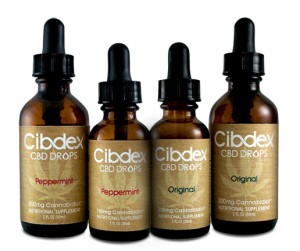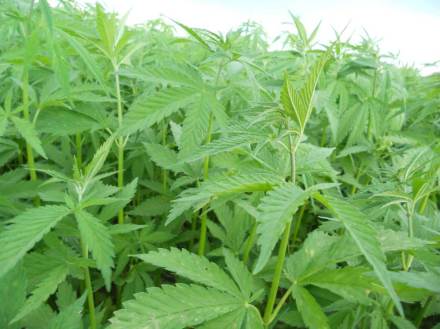Medical Marijuana, Inc (MJNA) and CannaVest Corp (CANV) have consistently been in the news as their products have been showcased across the nation. The new product lines Cibdex™ and Cibaderm™ have received much positive press, and since they are providing new revenue streams for the company, investors should be very satisfied to see this type of progress being made. Now add the newly released anti-aging product line, Cannabis Beauty DEFINED™ , which was introduced at the American Academy of Anti-Aging Medicine (A4M) conference, and what you have is an impressive lineup of mainstream offerings that are sure to catch the consumer’s eye. However, what’s really interesting is what ties these newer products and, of course, the company’s legacy products (CanChew™ CBD gum and Real Scientific Hemp Oil™) together–the high quality, award-winning natural hemp cannabidiol (CBD) that goes into each.
HempMedsPX, the contracted marketing company and exclusive master distributor for MJNA and CANV, recently represented the CannaVest product, CBD Simple, at the 2013 High Times Cannabis Cup Competition in Amsterdam. The prototype CBD product took top honors for Highest CBD Concentration at the annual event. This major milestone was preceded by winning another award for highest CBD content at both the 2013 Seattle High Times Cannabis Cup and the Michigan Medical Marijuana Conference “Green Cup”. With all these exiting things happening, I thought it was about time that I paid the company a visit to see first-hand what was fueling all these accomplishments. For the record, at the time of my trip, the Amsterdam High Times win and the Cannabis Beauty DEFINED™ product releases had not yet occurred.
I landed a little later than planned in San Diego after the plane was diverted to LA for gas. Once on the ground in “America’s finest city”, I grabbed my rental car and made my way to the company. Then…WOW!
I was really surprised to see all the “hustle and bustle” that was going on. I first met Chairman and Chief Operating Officer (COO) Michelle Sides, who was extremely gracious, and was then given the grand tour of the facilities. Everyone was very nice and knowledgeable about how they contributed to the operations of the company. What was most pleasing, from a work perspective, was how everyone collaborated and seemed to genuinely enjoy working together. There were still some minor renovations going on to optimize work space, but when the FedEx truck showed up to take away the day’s shipments, I got a sense of realism about how far the new focus on marketing and distribution had come.
Later that evening, I was given a tour of the CannaVest lab. My father was a research chemist for the US Army who had taken me to work with him on many occasions when I was younger, and so I thought I had somewhat of a good reference point to gauge equipment levels. My expectations were that there would be much less equipment needed to produce CBD, given the technology advances since my father’s chemist days, but I was wrong. VERY wrong. As the many different pieces of equipment were explained, I began to understand the intricate specialization that went into equipping this facility.
When I spoke with the masterminds behind the whole operation, I was incredibly impressed with their credentials and professionalism. Joshua Hartsel, Ph.D. (the Senior Research Scientist at CannaVest), who is in charge of lab operations, while proud of the accomplishments and accolades that his work had achieved, was really more appreciative of how those advancements have provided those in need with life-changing health and wellness alternatives. Joshua, who received his Ph.D. in Medicinal Organic Chemistry from Virginia Polytechnic Institute and State University, spoke at length about the benefits of the lab. The overriding theme of our conversations was quality control. Being able to guarantee dosages, meet production needs, and reduce costs of production seemed to be Joshua’s main tenants of achieved success.
The capabilities that Joshua brings are not only a product of his considerable education; they are also derived from his many accomplishments and his experience in the industry. He served on the board of the Association of California Cannabis Laboratories (ACCL) and also ran a testing facility for several years prior to joining the CannaVest team. It’s also noteworthy to mention that he has extensive experience designing and testing for insecticides for the Bill and Melinda Gates Foundation, which is important for the cannabis industry.
Along with his focus on quality, Joshua was also pleased with the lab’s ability to further enhance the purity of natural CBD-rich hemp oil to levels that had previously been thought impossible.
This is where Greg Waterbury, the other gentleman instrumental in the lab’s setup and administration, stepped in to add his thoughts. Greg is a Project Manager for CannaVest. Greg attended Syracuse University and brings over 20 years of experience in life sciences to the team. He specializes in setting up new lab facilities for startups and for managing growth new facilities bring to companies. Greg was quick to point out that he, too, was impressed with the accomplishments of the lab–especially that the lab had realized CBD isolation of up to 97% (pharmaceutical grade) purification levels.
I asked Greg what he thought of the lab from purely a business perspective. He felt that its greatest business asset was that it stabilized the supply chain, thereby reducing the risk of not having timely and quality constituents. Never willing to compromise quality, Greg said that the lab enabled the company to be the “masters of our own destiny”. When I asked what the biggest challenges were in setting up the lab, Greg pointed out that they were purely architectural; their cutting-edge equipment selection required them to knock down walls to get that equipment through the door! He then extolled Joshua’s choices of this high-tech equipment, lauding the lab’s new capabilities to increase research and development (R&D) and to bring new products into development.
I could hear the pride in these two gentlemen’s voices as they spoke of their accomplishments. After winning some of the industry’s highest awards for CBD concentrations, that pride is well deserved. With the capabilities of the lab and the expertise and experience that Joshua and Greg bring to the table, I suspect the MJNA and CANV will have many surprises in the form of product expansion in the near future. And with the production efficiencies gained by the new facilities, at greater price points too!
Disclosure: I am an investor in MJNA and this article was written on behalf of Medical Marijuana, Inc.
Related articles
- Medical Marijuana, Inc & the CannaVest Investment (ireport.cnn.com)
- Medical Marijuana Inc. Announces Third Quarter 2013 Shareholders Report (virtual-strategy.com)
- Medical Marijuana Inc. Announces Third Quarter 2013 Shareholders Report (hispanicbusiness.com)
- Medical Marijuana Inc.’s HempMedsPX Enters Anti-Aging Market (hispanicbusiness.com)
- Social Media – A Treasure Trove of Information for MJNA & CANV Investors (ireport.cnn.com)
- Investing In a Transformational Cannabis Businesses – MJNA (ireport.cnn.com)





































